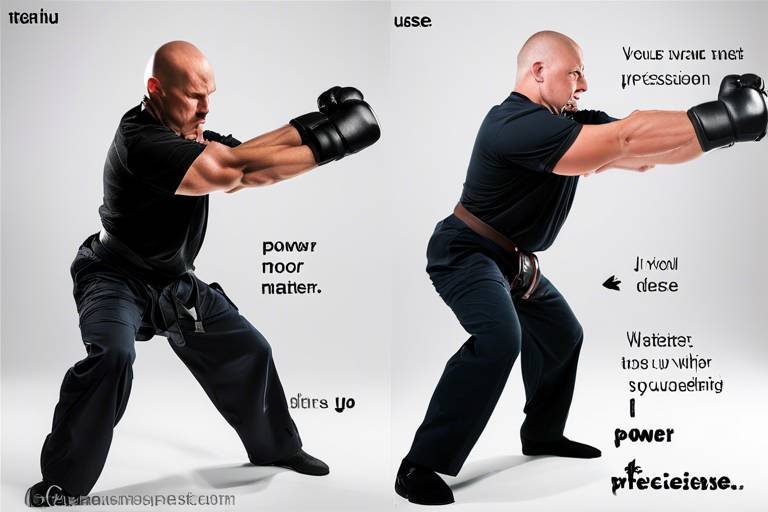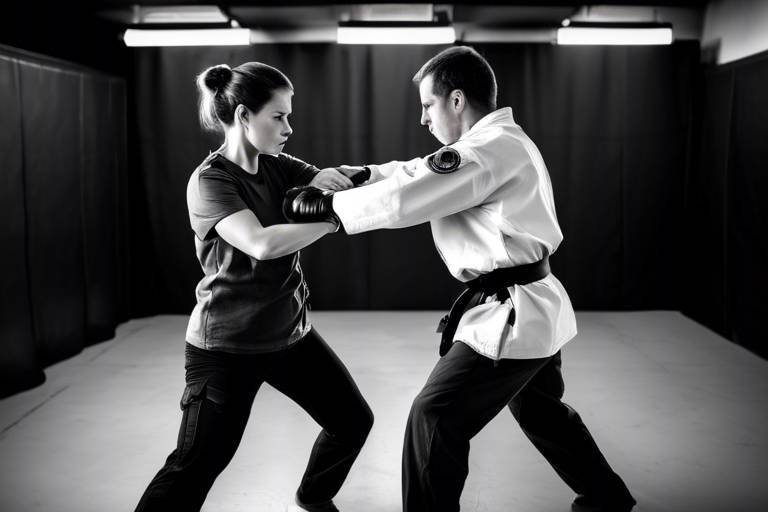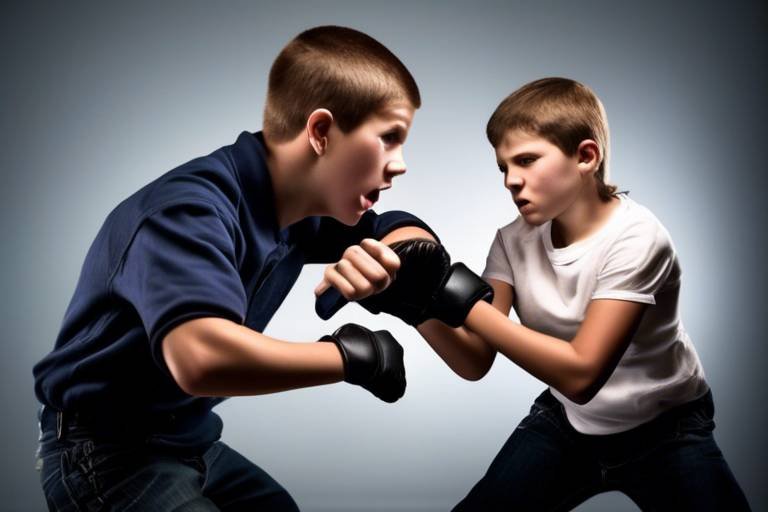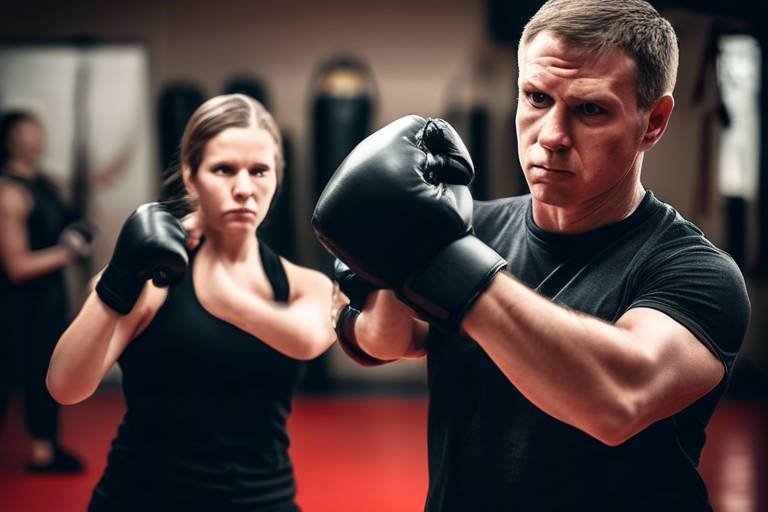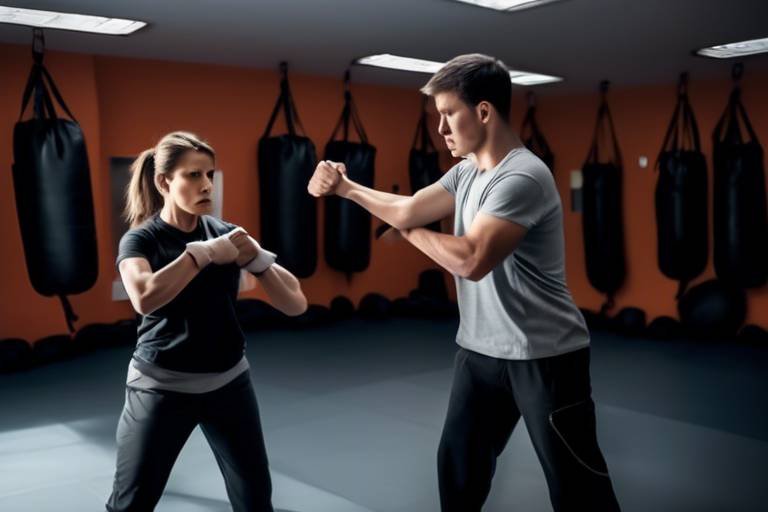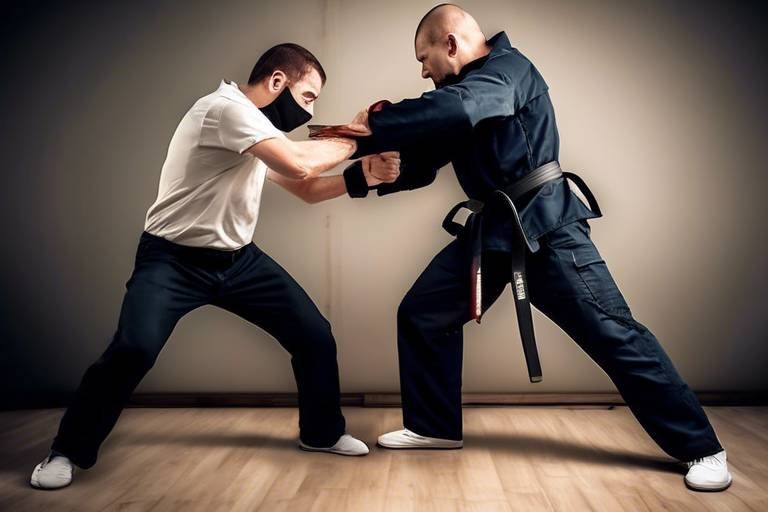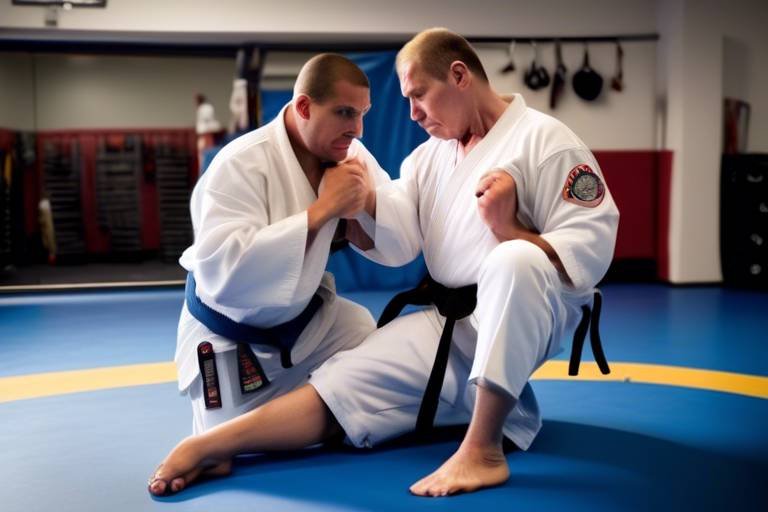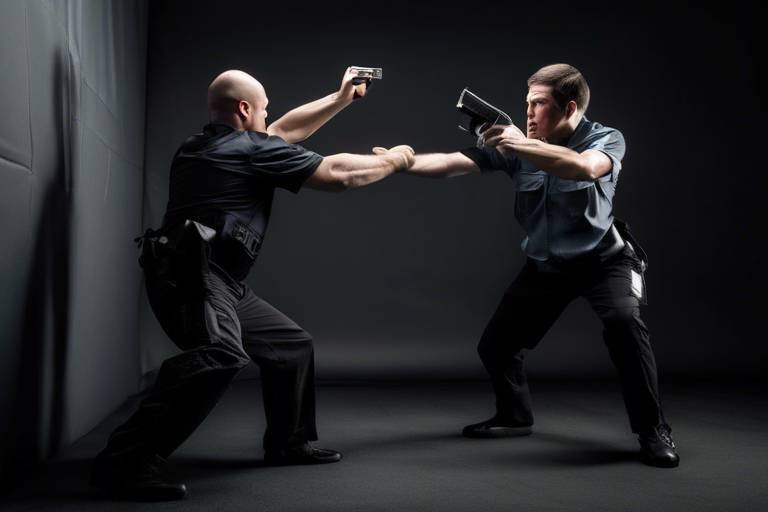Five Misunderstood Concepts in Self-Defense Techniques
This article explores common misconceptions surrounding self-defense techniques, highlighting the importance of understanding these concepts for effective personal safety and empowerment in various situations. Self-defense is often seen as a last resort, a reactive measure taken in the heat of the moment. However, many people fail to grasp the nuances that come with it. It’s not just about knowing how to throw a punch or execute a perfect kick; it’s about understanding the broader context of safety, legality, and personal empowerment. Let’s dive into five critical misconceptions that can significantly impact your self-defense journey.
Many believe that self-defense effectiveness relies solely on physical strength or size. This is a dangerous misconception. While it’s true that a larger opponent may have physical advantages, the reality is that technique, strategy, and awareness often play a more critical role in successful self-defense. Think of it like this: a small, agile person can outmaneuver a larger, slower opponent. Self-defense techniques are designed to exploit vulnerabilities, leverage body mechanics, and utilize the element of surprise. This means that anyone, regardless of their size, can be equipped to defend themselves effectively.
Understanding the legal ramifications of self-defense actions is crucial. Many individuals mistakenly believe that any form of self-defense is justified, neglecting the importance of proportionality and necessity in legal contexts. For instance, if someone pushes you, does that justify a punch in return? The answer is often more complicated than it seems. Each jurisdiction has its own laws regarding self-defense, and knowing these can help you navigate the murky waters of legality.
In some jurisdictions, individuals are required to retreat from a threat if safe to do so. This concept is often misunderstood, leading to confusion about when self-defense can be legally invoked. For example, if you find yourself in a threatening situation, the law may require you to back away rather than engage unless you're cornered. This duty to retreat can be a lifesaver, but it can also lead to hesitation in critical moments.
Stand Your Ground laws allow individuals to use force without retreating in certain situations. However, these laws vary significantly by state, contributing to misunderstandings about self-defense rights. It’s essential to know your local laws to avoid potentially dire consequences. In some states, you can defend yourself without retreating, while in others, you must demonstrate that retreat was impossible.
The Castle Doctrine permits individuals to use force to protect their homes. Misunderstandings about this doctrine can lead to unlawful actions and severe legal consequences. Many believe that they can use any level of force if someone enters their home, but the reality is that the response must still be proportional to the threat. If someone is merely trespassing, using lethal force could land you in legal hot water.
Proportionality is a key principle in self-defense, where the response must match the threat level. Misunderstanding this can lead to excessive force and legal repercussions. For example, if someone shoves you, responding with a weapon can be seen as excessive. Understanding these nuances is crucial for anyone interested in self-defense.
Many overlook the importance of situational awareness and avoidance in self-defense. Recognizing potential threats and avoiding confrontation can be more effective than physical techniques. Imagine walking into a crowded place; being aware of your surroundings can help you identify who seems suspicious or if a situation is escalating. This proactive approach can save you from having to engage in self-defense at all.
Situational awareness involves being mindful of your environment. This skill can help prevent dangerous situations before they escalate, emphasizing the importance of proactive self-defense strategies. It’s about tuning into your instincts and recognizing when something feels off. By developing this skill, you can often avoid confrontations altogether.
De-escalation techniques can effectively diffuse tense situations without resorting to physical confrontation. Understanding and practicing these techniques can enhance overall self-defense capabilities. For instance, if someone is shouting at you, knowing how to calmly communicate can often defuse the situation rather than escalating it into a physical altercation.
Many self-defense techniques are misrepresented in popular media, leading to unrealistic expectations. Understanding the practical application and limitations of these techniques is essential for effective self-defense. Movies often portray fight scenes that are choreographed and unrealistic, giving viewers a false sense of what self-defense looks like in real life.
While martial arts can provide valuable skills, they are not always practical in real-life situations. Misconceptions about their effectiveness can lead to overconfidence and inadequate preparation. It’s crucial to understand that training in a controlled environment is vastly different from facing a real threat.
Adrenaline can significantly affect performance during a confrontation. Misunderstanding its impact may lead individuals to underestimate the importance of training under stress. When faced with danger, your body’s fight-or-flight response kicks in, which can cloud judgment and impair motor skills. Training under stress can help you learn how to manage this response.
Training for self-defense is often misunderstood, with many believing that a few classes will suffice. Continuous practice and realistic training scenarios are essential for effective self-defense readiness. Think of it like learning to drive; you wouldn’t feel confident after just one lesson, right? Self-defense training requires ongoing commitment and practice to ensure that skills are sharp and responses are instinctive.
Training in realistic scenarios helps prepare individuals for actual confrontations. Misunderstandings about training environments can lead to inadequate preparation for real-life situations. Practicing in a safe, controlled environment is beneficial, but it’s crucial to simulate real-world scenarios to ensure readiness.
Not all self-defense programs are created equal. Understanding what to look for in a program can help individuals find the training that best suits their needs and goals. Researching instructors, class structures, and training methodologies can make a significant difference in your self-defense journey.
- What is the best self-defense technique for beginners? It's essential to start with basic awareness and avoidance techniques, then gradually incorporate physical self-defense skills.
- Can I use self-defense techniques in any situation? No, it's crucial to understand the legal implications and ensure your response is proportional to the threat.
- How often should I train for self-defense? Regular practice is key; aim for at least once a week to keep skills sharp.

1. The Myth of Size and Strength
When it comes to self-defense, there's a prevalent myth that size and strength are the ultimate determinants of success. Many people believe that if they are smaller or weaker than an attacker, they stand little chance of defending themselves. However, this notion is not only misleading but can also be detrimental to one's confidence and preparedness. In reality, effective self-defense relies much more on technique, strategy, and awareness than sheer physical power.
Consider this: a well-placed kick or a quick escape can be far more effective than a brute force tackle. The essence of self-defense lies in understanding how to leverage your environment and utilize your body in ways that can neutralize a threat. For instance, striking vulnerable areas such as the eyes, throat, or groin can incapacitate an attacker, regardless of their size. This is why many self-defense classes emphasize techniques that are accessible to everyone, irrespective of their physical attributes.
Moreover, self-defense is not just about physical confrontation; it also involves mental preparedness. A person who is aware of their surroundings and can assess a situation critically often has the upper hand. Imagine walking down a street and noticing a suspicious group ahead. Instead of waiting for trouble to find you, your awareness allows you to change your path or seek help, effectively avoiding a potentially dangerous situation altogether.
It's also worth noting that many self-defense experts advocate for the use of de-escalation techniques. These strategies focus on diffusing a situation before it turns violent. The ability to communicate effectively, maintain a calm demeanor, and create distance can often prevent a confrontation from escalating. This approach highlights that self-defense is not merely about fighting back but also about avoiding conflict whenever possible.
In summary, while size and strength can play a role in physical confrontations, they are far from the only factors that determine success in self-defense. Emphasizing technique, awareness, and the ability to de-escalate situations will empower individuals of all sizes and strengths to protect themselves effectively. Remember, the goal of self-defense is not to win a fight but to escape safely and avoid confrontation altogether.
- Do I need to be physically strong to defend myself? No, effective self-defense relies more on technique and awareness than on physical strength.
- What should I focus on in self-defense training? Focus on learning techniques that target vulnerable areas and developing situational awareness.
- Can self-defense techniques work for anyone? Yes, self-defense techniques can be adapted for individuals of all sizes and strengths.

2. Misconceptions About Legal Implications
When it comes to self-defense, many people harbor significant misconceptions regarding the legal implications of their actions. This lack of understanding can lead to dire consequences, both legally and personally. One of the most common myths is the belief that any form of self-defense is justified, regardless of the circumstances. In reality, the law often requires a nuanced approach to self-defense, emphasizing the importance of proportionality and necessity.
To clarify, let's break down some of the key concepts that are often misunderstood:
- Proportionality: This principle states that the level of force used in self-defense must be appropriate to the threat faced. For example, if someone is merely pushing you, responding with lethal force could result in legal repercussions.
- Duty to Retreat: In many jurisdictions, individuals are required to retreat from a threat if it is safe to do so. This means that if you can avoid a confrontation without putting yourself in danger, the law may expect you to do so.
- Stand Your Ground Laws: These laws allow individuals to use force without retreating in certain situations. However, they vary greatly by state, leading to confusion about when and how they apply.
- Castle Doctrine: This legal principle permits individuals to use force to protect their homes. Misunderstanding this doctrine can lead to severe legal consequences, as it is not a blanket permission to use force in all situations.
Understanding these concepts is crucial for anyone interested in self-defense. Misinterpretations can lead to excessive force being used, which not only jeopardizes your safety but can also lead to criminal charges. For instance, if someone believes they can use deadly force simply because they feel threatened, they may be in for a rude awakening when faced with legal scrutiny.
Moreover, the principle of proportionality is not just a legal requirement; it is also a moral one. The idea is to respond appropriately to a threat, ensuring that your actions are justifiable. A well-informed individual understands that self-defense is not about winning a fight but about protecting oneself while minimizing harm to others.
In summary, the legal implications surrounding self-defense are complex and often misunderstood. Being aware of the legal landscape can empower individuals to act wisely and responsibly in threatening situations. Always consult with legal experts or self-defense instructors who can provide accurate information tailored to your local laws.
Here are some common questions regarding misconceptions about legal implications in self-defense:
- Is it legal to use force if I feel threatened? - Not always. The law requires that your response be proportional to the threat.
- What is the duty to retreat? - In many places, you must retreat from a threat if it is safe to do so before resorting to force.
- What are Stand Your Ground laws? - These laws permit individuals to use force without retreating in certain situations, but they vary by state.
- Can I use force to protect my property? - The Castle Doctrine may apply, but it's essential to understand the specific laws in your area.

2.1. The Duty to Retreat
The concept of the Duty to Retreat can be quite perplexing for many individuals seeking to understand their rights when it comes to self-defense. In essence, this principle requires a person to withdraw from a threatening situation, if it is safe to do so, before resorting to any form of defensive action. This is not just a moral guideline; in some jurisdictions, it is a legal requirement. Imagine being in a heated argument that escalates into a physical confrontation. If there’s a clear path to safety, the law might expect you to take that route rather than engage. This notion can often lead to confusion, especially when people believe that they can immediately retaliate without considering the option of retreat.
Understanding the Duty to Retreat is critical, as it varies significantly depending on where you live. Some states have laws that mandate retreat, while others have adopted more lenient approaches. To illustrate this, let’s break down the concept further:
| State | Duty to Retreat Requirement |
|---|---|
| California | Yes, if safe to do so. |
| Florida | No, Stand Your Ground law applies. |
| Texas | No, Stand Your Ground law applies. |
| New York | Yes, if safe to do so. |
As you can see, the rules can differ dramatically from one state to another, making it essential for individuals to be well-informed about their local laws. The confusion often arises when people mistakenly believe that self-defense is a blanket justification for any response to a threat, ignoring the nuances of legal definitions and requirements.
Moreover, the Duty to Retreat is not just a legal consideration; it also reflects a broader philosophy about conflict resolution. By prioritizing de-escalation and avoidance over confrontation, individuals can potentially prevent dangerous situations from escalating into violence. It emphasizes the importance of being aware of your surroundings and recognizing when it's time to walk away. In many cases, the best self-defense strategy is to simply avoid the fight altogether.
In conclusion, understanding the Duty to Retreat is pivotal for anyone interested in self-defense. Not only does it equip individuals with the knowledge to navigate legal landscapes, but it also encourages a mindset that values personal safety and conflict avoidance. So, the next time you find yourself in a potentially dangerous situation, remember that sometimes the wisest course of action is to step back rather than step forward.
- What is the Duty to Retreat? The Duty to Retreat is a legal principle requiring individuals to withdraw from a threatening situation if it is safe to do so before using force.
- Do all states have a Duty to Retreat? No, the requirement varies by state. Some states have Stand Your Ground laws that allow individuals to use force without retreating.
- What happens if I don’t retreat and use force? If you use force without attempting to retreat when required, you may face legal consequences, including criminal charges.

2.1.1. Stand Your Ground Laws
Stand Your Ground laws are a hot topic in the realm of self-defense, often stirring up debate and confusion. In essence, these laws allow individuals to use force, including deadly force, without the obligation to retreat when they believe they are facing an imminent threat. This concept can sound empowering, but it comes with a hefty dose of responsibility and the need for clarity. The laws vary significantly from state to state, which can lead to misunderstandings about what actions are legally justified.
For instance, in some states, you have the right to "stand your ground" if you are in a place where you have a legal right to be. However, it's crucial to understand that this does not give a blanket permission to use force in any situation. The circumstances surrounding the perceived threat, the level of force used, and the specific laws of your state all play a critical role in determining whether the use of force is justified.
Here are a few key points to consider regarding Stand Your Ground laws:
- Legal Right to Remain: You can stay in a location where you have the legal right to be, without the obligation to retreat if threatened.
- Reasonable Perception of Threat: You must genuinely believe that you are facing a threat of serious bodily harm or death.
- Proportional Response: The level of force you use must be proportional to the threat you perceive; excessive force can lead to legal complications.
It's important to note that while Stand Your Ground laws can empower individuals to defend themselves, they can also lead to serious legal consequences if misapplied. Misunderstandings about these laws can result in tragic outcomes, making it imperative for individuals to educate themselves on the specifics of their state's legislation. Always consult legal experts or local law enforcement to gain a comprehensive understanding of your rights and responsibilities under the law.
In summary, while Stand Your Ground laws are designed to protect individuals facing threats, they require a nuanced understanding of the legal landscape. Ignorance of these laws can lead to severe repercussions, so arming yourself with knowledge is just as important as any self-defense technique you might learn.

2.1.2. Castle Doctrine Explained
The Castle Doctrine is a legal principle that allows individuals to use reasonable force to protect their home, or "castle," from intruders. This doctrine is based on the belief that a person has the right to defend their home against unlawful entry and potential harm. However, the specifics of this doctrine can vary significantly from one jurisdiction to another, leading to confusion and potential legal issues for those who may not fully understand their rights.
In essence, the Castle Doctrine provides individuals with a legal shield against prosecution when they use force in defense of their home. But what does this really mean in practical terms? Here are a few key points to consider:
- Reasonable Belief: The individual must have a reasonable belief that the intruder poses an imminent threat of harm.
- Proportional Response: The level of force used must be proportional to the threat faced. For example, using deadly force against a non-lethal threat may not be justified.
- Location Matters: The Castle Doctrine typically applies to one’s home, but some jurisdictions extend this protection to other locations such as vehicles or businesses.
It's important to note that while the Castle Doctrine gives individuals certain rights, it does not provide a blanket approval for any form of violence. Misunderstanding this can lead to severe legal consequences, including criminal charges. For example, if someone uses excessive force against an intruder who is merely trespassing without any intent to harm, they could face legal repercussions, even under the Castle Doctrine.
Additionally, the Castle Doctrine does not apply in all situations. In some states, individuals are required to retreat from a threat if it is safe to do so, complicating the legal landscape surrounding self-defense. Therefore, it's crucial to be aware of the specific laws in your state regarding the Castle Doctrine and self-defense.
In summary, while the Castle Doctrine can empower individuals to protect their homes, it is essential to understand its limitations and the legal nuances that govern its application. Failing to grasp these concepts can lead to unintended consequences that could have been avoided with proper knowledge and preparation.
Here are some common questions regarding the Castle Doctrine:
- Is the Castle Doctrine the same in every state? No, the Castle Doctrine varies by state, and it's crucial to understand your local laws.
- Can I use deadly force if someone breaks into my home? Only if you reasonably believe that your life is in imminent danger. The response must be proportional to the threat.
- Does the Castle Doctrine apply outside my home? In some jurisdictions, yes, but it depends on local laws. Always check your state's regulations.

2.2. Proportionality in Self-Defense
When it comes to self-defense, one of the most critical yet often misunderstood concepts is proportionality. This principle asserts that the response to a threat must be appropriate and match the level of danger presented. Imagine this: if someone pushes you, responding with a lethal weapon is not only excessive but also legally questionable. The law generally dictates that your reaction should be proportional to the threat. This means that if the threat is minor, such as verbal harassment or a shove, your response should also be minor—perhaps simply walking away or using verbal de-escalation techniques.
The proportionality principle serves as a guideline to ensure that individuals do not escalate situations unnecessarily. It is essential to understand that self-defense is not a free pass to respond with overwhelming force. For instance, if you find yourself in a situation where someone is attempting to rob you, using a weapon may be justified if you genuinely believe your life is in danger. However, if the assailant is unarmed and only trying to steal your belongings, responding with deadly force could lead to severe legal consequences.
To further illustrate this concept, let's consider a simple table that outlines different scenarios and appropriate responses:
| Scenario | Threat Level | Appropriate Response |
|---|---|---|
| Someone shouts insults at you | Low | Ignore or walk away |
| Someone pushes you | Moderate | Defensive stance or verbal de-escalation |
| Someone threatens you with a weapon | High | Use of force may be justified |
Understanding this principle is vital not only for personal safety but also for ensuring that you remain within the bounds of the law. Misunderstanding proportionality can lead to situations where individuals use excessive force, resulting in criminal charges or civil liability. In many jurisdictions, the law requires that the force used in self-defense must be necessary and reasonable given the circumstances. This means that if you have the option to retreat or avoid confrontation, that should be your first course of action.
In summary, the concept of proportionality in self-defense is about ensuring that your response is measured and appropriate to the threat you face. It encourages individuals to think critically and act wisely, rather than react impulsively. By understanding and applying this principle, you can better protect yourself while also staying within legal boundaries.
- What is proportionality in self-defense?
Proportionality in self-defense means that your response to a threat should match the level of danger presented. - Can I use force if I feel threatened?
Yes, but the force used must be reasonable and necessary given the circumstances. - What happens if I use excessive force?
Using excessive force can lead to criminal charges or civil liability. - Is it better to retreat than to confront?
Whenever possible, retreating or avoiding confrontation is recommended.

3. The Role of Awareness and Avoidance
When it comes to self-defense, many people immediately think of physical techniques or martial arts. However, the truth is that awareness and avoidance play a crucial role in personal safety. Imagine you’re walking down a street, and you notice a group of individuals behaving suspiciously. Instead of waiting to see what happens, your first instinct should be to change your route or find a well-lit area with more people around. This simple act of awareness can often prevent a confrontation before it even begins.
Situational awareness is like having a sixth sense; it’s about being conscious of your surroundings and recognizing potential threats. It’s not just about looking around but actively engaging with your environment. This skill can be developed through practice and mindfulness. For instance, when entering a new place, take a moment to observe exits, the behavior of others, and any potential hazards. By doing so, you’re not only preparing yourself to react but also reducing the likelihood of encountering dangerous situations.
Moreover, avoidance is a powerful tool in the self-defense arsenal. It’s about making smart choices to steer clear of dangerous situations. For example, if you find yourself in a tense situation, consider using de-escalation techniques to diffuse the tension. This might involve calmly communicating with the other party or simply walking away if the situation allows. Remember, the goal is not to prove your strength but to ensure your safety. As the saying goes, “Better safe than sorry.”
Incorporating awareness and avoidance into your self-defense strategy doesn’t mean you have to live in fear. Instead, it empowers you to take control of your safety. Consider the following tips to enhance your awareness and avoidance skills:
- Practice Mindfulness: Regularly engage in mindfulness exercises to improve your focus and situational awareness.
- Stay Alert: Avoid distractions like your phone when in public spaces. Being present can help you notice potential threats.
- Trust Your Instincts: If something feels off, it probably is. Don’t hesitate to remove yourself from the situation.
In conclusion, the role of awareness and avoidance in self-defense cannot be overstated. By honing these skills, you not only enhance your safety but also cultivate a mindset that prioritizes prevention over reaction. Remember, the best fight is the one you avoid altogether.

3.1. Developing Situational Awareness
Developing situational awareness is one of the most critical skills you can acquire for personal safety. It’s not just about being aware of your surroundings; it’s about understanding the dynamics of your environment and recognizing potential threats before they escalate. Imagine walking through a crowded street, your senses heightened, noticing the subtle cues that indicate something isn’t right. This proactive approach can be the difference between avoiding danger and being caught off guard.
To enhance your situational awareness, consider these key components:
- Observation: Train yourself to observe details in your environment. Are people behaving unusually? Is someone following you? The more you practice observing, the better you’ll become at spotting potential threats.
- Listening: Pay attention to sounds around you. Unusual noises can signal danger. For instance, if you hear raised voices or a commotion, it’s wise to assess the situation from a safe distance.
- Intuition: Trust your gut feelings. If something feels off, it probably is. Your subconscious picks up on cues that your conscious mind may overlook.
Practicing situational awareness can be likened to honing a sixth sense. Just as a seasoned detective notices the smallest details that others miss, you can train yourself to be more attuned to your surroundings. Engage in activities that challenge your awareness, such as walking in busy public places and consciously noting the people and interactions around you. Over time, this practice will sharpen your instincts and help you identify threats more effectively.
Moreover, situational awareness isn’t just about spotting danger; it’s also about understanding how to react. Knowing when to walk away from a situation or when to seek help can be just as crucial as the ability to defend yourself physically. In essence, developing situational awareness is about empowering yourself to make informed decisions that prioritize your safety.
In conclusion, the journey to enhancing your situational awareness is ongoing and requires consistent practice. By actively engaging with your environment and honing your observational skills, you can significantly increase your ability to detect and avoid potential threats, making you a more confident and capable individual in any situation.
- What is situational awareness? Situational awareness is the ability to perceive and understand your surroundings and the potential threats within them.
- How can I improve my situational awareness? You can improve your situational awareness by practicing observation, listening actively, and trusting your intuition.
- Why is situational awareness important for self-defense? It allows you to recognize potential threats before they escalate, enabling you to avoid dangerous situations or respond effectively.

3.2. The Importance of De-escalation
When it comes to self-defense, one of the most powerful tools at your disposal may not be a punch or a kick, but rather the ability to de-escalate a situation. Think of de-escalation as a way to defuse a bomb before it detonates; it’s all about recognizing the tension and finding a way to diffuse it before things get out of hand. This technique involves using verbal communication, body language, and a calm demeanor to ease the intensity of a confrontation. In many cases, simply talking things out can prevent a physical altercation from ever occurring.
In a world where tempers can flare and misunderstandings abound, having the skill to de-escalate can be invaluable. Imagine walking into a bar where a heated argument is brewing. Instead of jumping in with fists flying, a skilled individual might approach with a friendly demeanor, acknowledging the feelings of both parties and steering the conversation towards a more peaceful resolution. This not only protects oneself but also promotes a culture of peace and understanding.
Here are some key components of effective de-escalation:
- Active Listening: Show that you are genuinely interested in what the other person is saying. Nodding and maintaining eye contact can go a long way in making the other person feel heard.
- Calm Tone: Your voice can set the tone for the entire interaction. Speaking softly and slowly can help to reduce the emotional temperature of the situation.
- Empathy: Acknowledge the other person's feelings and perspective. This doesn’t mean you have to agree, but validating their emotions can help reduce hostility.
- Non-Threatening Body Language: Keep your hands visible and avoid crossing your arms. Open body language can make you appear less confrontational.
De-escalation is not just about avoiding fights; it’s about creating safer environments for everyone involved. In high-stress situations, emotions can cloud judgment, leading to decisions that may have severe repercussions. By mastering the art of de-escalation, individuals empower themselves and those around them, transforming potential conflicts into opportunities for understanding and resolution.
Moreover, practicing de-escalation techniques can be as vital as learning physical self-defense moves. Training programs that incorporate these skills can significantly enhance an individual's overall self-defense capabilities. Just like martial arts, where the focus is on discipline and control, de-escalation requires practice and awareness. It’s essential to engage in role-playing scenarios where you can practice these techniques in a controlled environment, preparing yourself for real-life situations.
Ultimately, the goal of self-defense is not only to protect oneself but also to promote a culture of safety and respect. By emphasizing the importance of de-escalation, we can cultivate a society where conflicts are resolved through dialogue rather than violence. So, the next time you find yourself in a potentially explosive situation, remember that sometimes, the most powerful move is to talk it out.
Q: What is de-escalation in self-defense?
A: De-escalation in self-defense refers to techniques and strategies used to reduce the intensity of a conflict or confrontation, often through communication and non-threatening behavior.
Q: Can de-escalation techniques prevent physical confrontations?
A: Yes, effective de-escalation can often prevent a physical altercation by addressing the underlying issues and calming the involved parties.
Q: How can I learn de-escalation techniques?
A: Many self-defense classes include de-escalation training, and there are also workshops and resources available that focus specifically on communication and conflict resolution skills.
Q: Is de-escalation always effective?
A: While de-escalation can be highly effective, it may not work in every situation. It's important to assess the circumstances and prioritize personal safety.

4. Common Misunderstandings About Self-Defense Techniques
When it comes to self-defense, there are numerous misunderstandings that can lead individuals astray. One of the most prevalent myths is that self-defense techniques are always effective in real-life situations. Many people have been influenced by action movies and television shows, where characters effortlessly fend off attackers with flashy moves. However, the reality is far more complex. In a real confrontation, the effectiveness of these techniques can be significantly diminished by factors such as stress, surprise, and the unpredictable nature of human behavior.
Another common misconception is that simply knowing a few self-defense moves is enough to ensure personal safety. While having a basic understanding of techniques can be beneficial, it is crucial to recognize that self-defense is not just about physical prowess. It encompasses a variety of skills, including awareness, avoidance, and even verbal de-escalation. Many self-defense programs focus solely on physical techniques, neglecting the importance of these other vital components. This narrow focus can lead to a false sense of security and inadequate preparation for real-world scenarios.
Furthermore, the effectiveness of martial arts as a self-defense strategy is often overstated. While martial arts training can provide valuable skills and discipline, it does not automatically prepare individuals for every possible confrontation. The real-life application of martial arts techniques can differ significantly from practice sessions in a controlled environment. For instance, the adrenaline rush during an actual confrontation can cause even the most skilled martial artist to falter. Understanding this distinction is essential for setting realistic expectations about personal safety.
Additionally, many individuals underestimate the impact of adrenaline on their performance during a confrontation. When faced with a threatening situation, the body goes into fight-or-flight mode, leading to physiological changes that can impair judgment and coordination. This response can make it challenging to execute techniques learned in training, emphasizing the need for practice under stress. Training that simulates real-life scenarios can help individuals better prepare for the unpredictable nature of confrontations.
Ultimately, it’s essential to approach self-defense with a well-rounded perspective. This means acknowledging the limitations of techniques and understanding that personal safety often hinges on more than just physical confrontation. By focusing on the broader spectrum of self-defense—including awareness, avoidance, de-escalation, and realistic training—individuals can empower themselves to navigate potentially dangerous situations more effectively.
- What should I prioritize in self-defense training? Focus on situational awareness, de-escalation techniques, and realistic practice scenarios.
- Can martial arts be effective for self-defense? Yes, but it's important to understand their limitations and practice under realistic conditions.
- How does adrenaline affect my performance? Adrenaline can impair judgment and coordination, making it crucial to train under stress.
- Is self-defense only about physical techniques? No, effective self-defense includes awareness, avoidance, and verbal skills as well.

4.1. The Effectiveness of Martial Arts
When it comes to self-defense, many people often turn to martial arts as a go-to solution. However, it's essential to recognize that while martial arts can provide valuable skills, they are not always the magic bullet that popular culture makes them out to be. Think of martial arts like a toolbox; it has various tools that can be incredibly useful, but knowing when and how to use them is crucial for success.
One common misconception is that simply taking a few classes in martial arts will prepare someone for any real-life confrontation. The truth is, real-life situations are often chaotic and unpredictable, and the techniques learned in a controlled environment may not translate well when adrenaline is pumping and the stakes are high. In fact, many martial artists find that the techniques they’ve practiced in the dojo can become less effective when faced with the unpredictability of a real confrontation.
Moreover, it's vital to understand that martial arts training often emphasizes discipline, respect, and self-control. These principles are not just about learning how to throw a punch or execute a kick; they also involve understanding when to engage and when to walk away. In many cases, avoiding a confrontation altogether is the best form of self-defense. Therefore, martial arts should be seen as one part of a broader self-defense strategy that includes awareness, de-escalation techniques, and personal safety practices.
Additionally, the effectiveness of martial arts can vary significantly based on the style practiced. Some martial arts focus on striking (like boxing or kickboxing), while others emphasize grappling (like Brazilian jiu-jitsu or judo). Each style has its strengths and weaknesses, and understanding these can help individuals choose the right martial art for their needs. Here’s a brief overview of some popular martial arts styles and their focus:
| Martial Art | Focus | Strengths |
|---|---|---|
| Karate | Striking | Powerful punches and kicks |
| Brazilian Jiu-Jitsu | Grappling | Ground fighting and submissions |
| Muay Thai | Striking | Elbows and knees, clinch work |
| Judo | Grappling | Throws and takedowns |
In conclusion, while martial arts can undoubtedly provide valuable skills and techniques, they should not be viewed as a standalone solution for self-defense. It’s crucial to combine martial arts training with other self-defense strategies, such as improving your situational awareness and practicing de-escalation techniques. This comprehensive approach can significantly enhance your ability to protect yourself in various situations.
- Can martial arts guarantee my safety in a confrontation? No, while martial arts can be helpful, they do not guarantee safety. It's essential to combine them with awareness and avoidance strategies.
- How long does it take to become proficient in martial arts? Proficiency varies by individual and the style practiced, but it generally requires consistent training over several months or years.
- Are all martial arts effective for self-defense? Not all martial arts are equally effective for self-defense. It's important to choose a style that emphasizes practical techniques and real-life application.

4.2. The Impact of Adrenaline
When faced with a dangerous situation, the body often responds with a rush of adrenaline, a hormone that prepares us for "fight or flight." This physiological reaction can be both a blessing and a curse in self-defense scenarios. On one hand, adrenaline can enhance our strength, speed, and focus, allowing us to react quickly to threats. On the other hand, it can lead to impaired judgment and coordination, making it crucial to understand how to manage this response effectively.
Imagine you’re walking down a quiet street when suddenly you encounter a potential threat. Your heart races, your palms sweat, and you feel a surge of energy. This is your body gearing up for action. However, the same adrenaline that makes you feel invincible can also cloud your thinking. In a high-stress situation, you might find it challenging to recall self-defense techniques you've practiced. This is why training under stress is vital.
To illustrate the impact of adrenaline, consider the following effects it can have during a confrontation:
- Increased Heart Rate: This can lead to faster breathing and heightened awareness, but it can also result in fatigue.
- Tunnel Vision: You may focus solely on the threat, neglecting other important aspects of your environment.
- Reduced Fine Motor Skills: Complex techniques may become difficult to execute, which is why simpler, more instinctive responses are often recommended.
- Heightened Emotional Response: Fear can lead to panic, causing you to either freeze or react impulsively.
Understanding these effects can help you prepare mentally and physically for potential confrontations. Training that incorporates stress inoculation—practicing self-defense techniques while under simulated pressure—can be invaluable. This type of training helps individuals learn to manage their adrenaline response, allowing them to maintain composure and effectively apply their skills when it matters most.
Ultimately, recognizing the dual nature of adrenaline is essential for anyone interested in self-defense. It can be a powerful ally, enhancing your capabilities in critical moments, but it can also hinder your performance if not properly managed. By training in realistic scenarios and understanding how your body reacts under stress, you can become more adept at navigating the complexities of self-defense situations.
Here are some common questions regarding the impact of adrenaline in self-defense situations:
- How can I train to manage my adrenaline response?
Incorporate stress drills into your training sessions, such as sparring or scenario-based exercises, to simulate real-life confrontations.
- Does adrenaline affect everyone the same way?
No, individual responses to adrenaline can vary based on factors like experience, fitness level, and personality traits.
- What should I do if I freeze during a confrontation?
Practice mental visualization techniques and breathing exercises to help you remain calm and focused during high-stress situations.

5. Training Realities and Misconceptions
When it comes to self-defense, many people have a misguided perception that attending a few classes or watching a couple of online tutorials is all it takes to be prepared for any situation. This couldn't be further from the truth. Self-defense training is not just about learning a few moves; it's about developing a mindset, honing physical skills, and understanding the psychological aspects of confrontation. Just like a musician practices scales daily to master their instrument, self-defense requires continuous practice and dedication.
Moreover, it's crucial to grasp that not all self-defense programs are created equal. Some focus solely on physical techniques, while others incorporate mental preparedness, situational awareness, and de-escalation tactics. When choosing a program, consider the following factors:
- Instructor Experience: Look for instructors with a solid background in self-defense and real-world experience.
- Curriculum Focus: Ensure the program teaches a well-rounded approach, including physical techniques, legal knowledge, and psychological preparedness.
- Class Size: Smaller classes often allow for more personalized attention and better skill development.
- Realistic Scenarios: Training should include simulations that reflect real-life situations to prepare students for actual confrontations.
Another common misconception is that self-defense training is a one-time event. In reality, effective self-defense requires ongoing education and practice. Just like any skill, the more you train, the more instinctual your reactions will become. Regular training helps you to:
- Maintain physical fitness, which is essential in any self-defense scenario.
- Improve muscle memory, so you can react quickly under stress.
- Stay updated on new techniques and strategies that may emerge in the self-defense community.
Furthermore, it's important to acknowledge the role of adrenaline and stress during a confrontation. Many individuals underestimate how these factors can impact performance. Training under stress, such as in sparring sessions or high-pressure drills, can better prepare you for the real thing. Understanding how to manage your adrenaline response can mean the difference between panicking and effectively defending yourself.
In summary, the journey to becoming proficient in self-defense is ongoing and multifaceted. It requires a commitment to training, a willingness to learn, and an understanding of the realities of confrontation. By embracing this comprehensive approach, you empower yourself not just to defend against threats, but to navigate the world with greater confidence and awareness.
Q1: How often should I train for self-defense?
A1: Ideally, you should aim to train at least once a week, but more frequent sessions can significantly enhance your skills and confidence.
Q2: Can I learn self-defense online?
A2: While online resources can be helpful, they should complement in-person training. Physical practice with a qualified instructor is crucial for mastering techniques.
Q3: What should I look for in a self-defense class?
A3: Look for experienced instructors, a comprehensive curriculum, and a focus on realistic training scenarios.
Q4: Is self-defense training suitable for everyone?
A4: Yes! Self-defense training is beneficial for individuals of all ages and fitness levels. It promotes confidence and personal safety.
Q5: What if I can’t afford formal training?
A5: There are many free resources available online, including videos and community workshops. However, investing in quality training is highly recommended for effective learning.

5.1. The Importance of Realistic Scenarios
When it comes to self-defense training, one of the most critical aspects that often gets overlooked is the importance of realistic scenarios. Many individuals might think that simply attending a few classes or practicing techniques in a controlled environment is enough to prepare them for a real confrontation. However, the truth is that the dynamics of a real-life situation can be vastly different from what you experience in a dojo or training studio.
Imagine for a moment that you’re in a park, enjoying a sunny day, when suddenly you find yourself faced with an aggressive individual. The adrenaline rush, the unexpected nature of the encounter, and the sheer unpredictability of human behavior can all lead to a chaotic and challenging situation. This is why training in realistic scenarios is essential. It helps you to not only practice your techniques but also to develop the mental fortitude and quick-thinking skills necessary to respond effectively under pressure.
Realistic training scenarios can include a variety of components that mimic real-life situations, such as:
- Different environments (e.g., streets, parks, crowded places)
- Varied attacker profiles (e.g., different sizes, genders, and aggression levels)
- Unexpected distractions (e.g., loud noises, bystanders)
By incorporating these elements into your training, you can build a more comprehensive skill set that prepares you for the unpredictability of real-world confrontations. Furthermore, it allows you to practice your situational awareness, decision-making, and de-escalation techniques in a safe, controlled environment, which can significantly enhance your overall self-defense capabilities.
In essence, the goal of realistic scenario training is to bridge the gap between theory and practice. It's not just about knowing how to execute a technique; it's about understanding when and how to apply it effectively in a high-stress situation. The importance of this training cannot be overstated, as it equips you with the tools necessary to protect yourself when it truly matters.
Ultimately, if your self-defense training doesn’t include realistic scenarios, you might find yourself ill-prepared when faced with a genuine threat. Just as a soldier wouldn’t go into battle without realistic combat training, you shouldn’t step into a potentially dangerous situation without having practiced how to handle it. So, take the time to seek out training programs that emphasize realistic scenarios, and you'll be better equipped to handle whatever life throws your way.
- What is the best way to prepare for a self-defense situation?
Training in realistic scenarios is crucial, along with maintaining situational awareness and practicing de-escalation techniques. - How often should I train for self-defense?
Regular practice is recommended, ideally at least once a week, to keep your skills sharp and your instincts ready. - Are all self-defense classes the same?
No, it's essential to research and find programs that focus on realistic scenarios and practical applications of techniques.

5.2. Finding the Right Self-Defense Program
Choosing the right self-defense program can feel overwhelming, especially with so many options available today. It’s essential to recognize that not all programs are created equal, and what works for one person may not suit another. When searching for a self-defense class, consider several key factors that can help you make an informed decision. First, think about your personal goals. Are you looking to learn basic self-defense techniques, or are you aiming for a more in-depth understanding of martial arts? Your objectives will guide your choice.
Next, assess the qualifications and experience of the instructors. A good instructor should have a solid background in self-defense or martial arts, ideally with teaching experience. Look for programs that emphasize real-life scenarios and practical techniques rather than just theoretical knowledge. You want to ensure that the training you receive is applicable to actual situations you might face.
Another critical factor is the training environment. A supportive, non-intimidating atmosphere can make a significant difference in your learning experience. Many people find it helpful to observe a class before enrolling. Pay attention to how the instructor interacts with students and whether the atmosphere feels welcoming. Additionally, consider the class size. Smaller classes often allow for more personalized attention, which can enhance your learning process.
Moreover, take the time to read reviews and testimonials from past students. This feedback can provide valuable insights into the program's effectiveness and the overall experience. You might also want to ask about the curriculum. A well-rounded program should cover a variety of self-defense techniques, including both physical skills and mental strategies.
Lastly, don’t forget about logistics such as location, schedule, and cost. Ensure that the program fits your lifestyle and budget. It’s better to find a program that you can consistently attend rather than one that is too far away or too expensive. By considering these factors, you can find a self-defense program that not only meets your needs but also empowers you to feel more confident and prepared.
Here are some common questions that individuals often have when considering self-defense training:
- What should I wear to a self-defense class? Comfortable clothing that allows for movement is recommended. Many people wear athletic gear.
- How long does it take to become proficient in self-defense? Proficiency varies by individual, but consistent practice over several months can lead to significant improvement.
- Are self-defense techniques effective for everyone? Yes, self-defense techniques can be adapted to suit individuals of all sizes and abilities.
- What if I have no prior experience in martial arts? Most self-defense programs welcome beginners and start with the basics.
- Is self-defense training only for women? No, self-defense training is beneficial for individuals of all genders and ages.
Frequently Asked Questions
- Is size and strength really important in self-defense?
No, not at all! Many people think that being bigger or stronger gives you the upper hand in a self-defense situation. However, the truth is that technique, strategy, and awareness are far more crucial. It's like David vs. Goliath; sometimes, the smaller, smarter fighter can outmaneuver the brute strength!
- What are the legal implications of using self-defense?
Understanding the legal side of self-defense is critical. Many assume that any action taken in self-defense is justified, but that's not the case. The law often requires a response to be proportional and necessary. In some places, you might even have a duty to retreat if it's safe to do so, so knowing your local laws is essential!
- What does "Stand Your Ground" mean?
"Stand Your Ground" laws allow individuals to use force without retreating in certain situations. However, these laws vary by state and can be confusing. It's vital to know the specifics of your state's laws to avoid any misunderstandings that could lead to serious consequences.
- What is the Castle Doctrine?
The Castle Doctrine permits individuals to use force to protect their homes. While it sounds straightforward, many misunderstand its limits and applications, which can lead to unlawful actions. Always be informed about how this doctrine works in your area!
- How important is situational awareness in self-defense?
Situational awareness is incredibly important! It's all about being mindful of your surroundings and recognizing potential threats before they escalate. Think of it as having a sixth sense; the more aware you are, the better you can avoid confrontations altogether!
- Can de-escalation techniques be effective?
Absolutely! De-escalation techniques can help diffuse tense situations without resorting to physical confrontation. It's like having a superpower; knowing how to calm things down can enhance your overall self-defense capabilities significantly.
- Are martial arts effective for self-defense?
While martial arts can be beneficial, they aren't always practical in real-life situations. Many people have unrealistic expectations due to what they see in movies. It's essential to combine martial arts training with real-world application to be truly prepared.
- How does adrenaline affect performance during a confrontation?
Adrenaline can have a significant impact on your performance in a high-stress situation. It can either enhance your abilities or hinder them, depending on how well you've trained under stress. Understanding this can help you prepare better for real confrontations.
- Is one self-defense class enough?
Not even close! Many people think they can just take a couple of classes and be ready for anything. In reality, continuous practice and exposure to realistic scenarios are key to being effective in self-defense. Think of it like learning to ride a bike; practice makes perfect!
- How do I find the right self-defense program?
Not all self-defense programs are created equal, so it's essential to do your homework. Look for programs that focus on realistic scenarios, experienced instructors, and a curriculum that fits your needs and goals. It's like finding the right gym; you want a place that motivates you and helps you grow!







